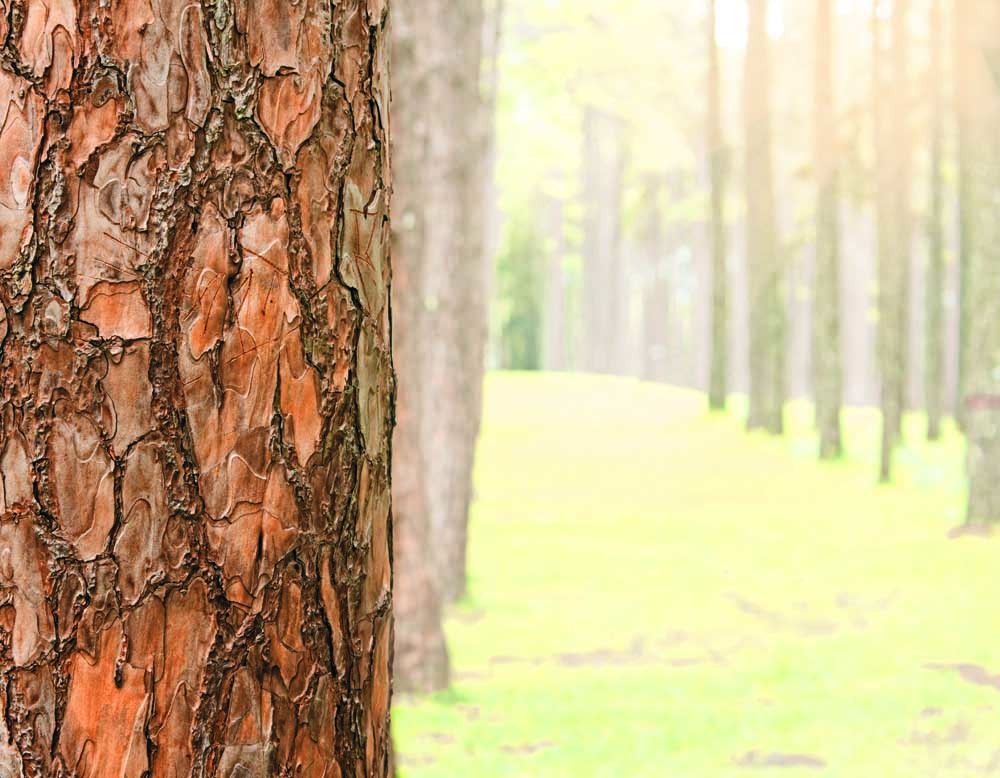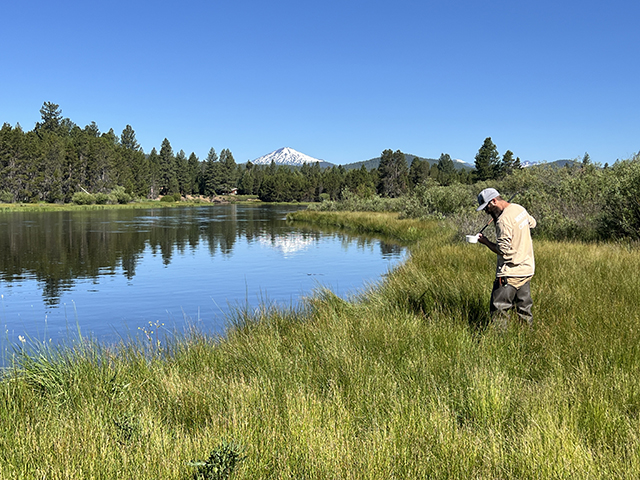A guide to Central Oregon’s chipmunks and squirrels
Published 12:00 am Thursday, August 16, 2018

- Pine forest. Close up pine bark with shallow dof
Everyone knows that the internet’s primary purpose is to provide a constant stream of animal videos.
Central Oregonians, however, don’t need to log on to get their daily dose of adorable critters. The pine cone-filled alleys and parks of Bend and the forests of Central Oregon are teeming with cuteness, particularly chipmunks, squirrels and marmots.
These rodents have fascinated Sara Gregory, a wildlife habitat biologist at the Oregon Department of Fish and Wildlife. Sometimes referred to as “rats with fuzzy tails,” these rodents predate humans in Central Oregon by eons and play a crucial role in the ecosystem, Gregory said, by essentially existing as food sources for a variety of winged and quadruped predators. They also contribute to forest ecology by spreading seeds. During their lifespans, these rodents busy themselves during spring and summer with building up fat reserves and procreating when not scurrying for cover or hibernating, which they do for much of the year.
“We’re lucky in a lot of ways to still have these native species,” Gregory said. “As cities get bigger, you don’t see them anymore.”
The height of summer is when ODFW receives the most complaints about the rodents, however, who sometimes invade backyard gardens or even people’s homes.
Whether people consider them pests or not, most can agree that these critters are exceptionally cute.
But that cuteness owes to their vulnerability. Rodents’ shiny black eyes, which slightly protrude from their eye sockets, are situated on the lateral side of the skull. This allows for a broader periphery to detect predators. Their pelt colors range from an ashy gray to a reddish cinnamon, allowing them to blend in with Central Oregon’s volcanic soil and vegetation.
And then there are those feathery tails that seem to have evolved for no other reason that to delight us with a sense of whimsy.
Their actual purpose includes self-shading, as if the animals evolved little parasols. They are also used for balance and a way to warn others of danger.
Below, Gregory has detailed five squee-tastic rodents native to Central Oregon that not only fuel the ecosystem, but also enliven our walks and hikes — and sometimes our garbage cans.
Chipmunk
Appearance/characteristics: The three chipmunk species of Central Oregon — which include the yellow-pine, least and Allen’s chipmunks — are so similar it’s difficult for the untrained eye to tell them apart, Gregory said.
Cinnamon and brown in color, they all have race car-like light and dark stripes that begin at the nose and wrap along their backs toward the tails. These stripes, which look like Zorro masks, distinguish chipmunks from golden-mantled ground squirrels.
Behavior: Chipmunks are often heard before they’re seen.
They make a shrill chirping sound when would-be predators approach. “It’s a pretty common sound if you know what to listen for. They’re basically food for almost everything out there,” Gregory said, listing birds of prey, coyotes, foxes, weasels and martens as potential chipmunk munchers. “They’re quite jittery little things. They run around with their tails sticking straight up into the air. That makes them a little endearing.”
Sighting spots: In the Badlands Wilderness, they live near sagebrush. In forests, chipmunks will spend some time in trees, but they split limb time with periods on the ground.
Hibernation: Chipmunks emerge from hibernation during the spring and early summer, a very busy time. ODFW receives many complaints about chipmunks invading gardens or finding ways into people’s homes if walls aren’t sealed up well.
Diet: They eat higher-protein parts of plants, such as pine cone seeds and berries.
Belding’s ground squirrel
Appearance/characteristics: Belding’s ground squirrel is a medium-sized ground squirrel without markings, according to ODFW. The fur is an ashy gray with some pink on the face, feet and underside. It has a reddish or brownish band down its back. The tail is cinnamon on its underside.
Behavior: Belding’s ground squirrel, also known as the “sage rat,” causes a lot of agricultural damage, digging holes that livestock can injure themselves in, Gregory said. A lot of farmers and private-land owners let people shoot at them, sometimes from double-decker buses for target practice, during the spring.
“They call them ‘sage rat safaris.’ It’s quite the economic boon for some people,” Gregory said.
Others are concerned about lead poisoning — the result of using traditional lead bullets — among the avian scavengers, including eagles, turkey vultures and red-tail hawks, who pick over the carcasses.
Sighting spots: Belding’s ground squirrel is found in sagebrush-dotted flats, small-grain and hay fields. It is sometimes found in woodland openings, according to ODFW.
Diet: This species eats seeds, nuts and fruits. It also eats some fungi and bird eggs.
Western gray squirrel
Appearance/characteristics: The western gray squirrel is Oregon’s largest tree squirrel.
It is solid gray with white on its underside.
“I think they’re quite attractive squirrels,” Gregory said. “They have a lot of personality; people are entertained by them.”
Behavior: This is the largest native tree squirrel in the Northwest. In Oregon, it is listed as a sensitive species, and it doesn’t do as well around human habitation as other squirrels and rodents.
“They get hit by cars a lot, and they don’t reproduce as quickly as Eastern gray squirrels, which can have two litters in one year,” Gregory said.
They can hang upside down in trees, made possible by near-opposable thumbs, wide hands and sharp claws that dig into the bark.
Sighting spots: Western gray squirrels build large nests out of sticks in trees. They’ll also take advantage of an empty tree cavity that has been carved out by woodpeckers, particularly in oak. Bird feeders, for better or worse, are a common place to spy western gray squirrels. They hop from tree to tree or on the ground in smooth, wavelike leaps, according to the Washington Department of Fish and Wildlife.
Hibernation: Like most tree squirrels, this one doesn’t hibernate, although it’s less active in the winter.
Diet: A true tree squirrel, the Western gray squirrel has adapted to finding food year-round, storing nuts and conifer seeds for the colder months. In the winter, it also forages for remnants of berries, seeds and even eats cambium, a rubbery layer found beneath tree bark, and some insects, such as beetles.
Golden-mantled ground squirrel
Appearance/characteristics: A ground dweller, this species features an identifying broad white stripe that is bordered by black ones that stretch from the shoulder to the hip, according to ODFW. The rest of its fur is golden brown.
Behavior: The golden-mantled ground squirrel searches the ground for food. It is especially prominent during late summer.
Sighting spots: Most of its activity happens on the ground where it zips among stumps, logs and other features, according to ODFW.
Hibernation: It hibernates from late autumn until late winter/early spring to mid autumn.
Diet: Like other squirrel species, the golden-mantled ground squirrel eats seeds, nuts and fruits. It also eats some fungi and bird eggs.
Yellow-bellied marmot
Appearance/characteristics: The yellow-bellied marmot is Oregon’s biggest squirrel, according to ODFW. It has short legs, a short, bushy tail and short, furry ears.
The rest of the body is covered in a thick underfur that is interspersed with long, coarse hairs. This is Oregon’s only marmot.
Sighting spots: They live around boulders or rock piles near lots of vegetation. In Bend, they’re found in grassy sections along the Deschutes River and in rocky landscaping features, particularly in the Old Mill District.
Hibernation: Marmots awaken from hibernation toward the end of February or beginning of March, according to ODFW. Adults are active for 135 to 150 days before they begin hibernating by the end of July.
Diet: The yellow-bellied marmot eats more grass than any other squirrel. It also eats blossoms and sometimes small insects.
— Reporter: 541-617-7816, pmadsen@bendbulletin.com








